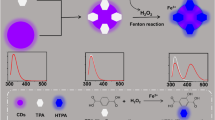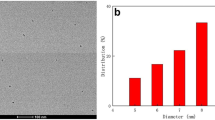Abstract
An “on–off–on” fluorescence sensor was designed for rapidly and consecutively detecting 4-nitrophenol and cerium(IV) without the use of any labeling materials. The yellow carbon dots were synthesized by a simple one-step hydrothermal approach, and various techniques were applied to investigate the morphology, structure, and optical properties of the carbon dots. Under the optimal experimental conditions, 4-nitrophenol rapidly quenched the fluorescence of carbon dots as a result of the inner filter effect (IFE). The fluorescence intensity of carbon dots was linear with the concentration of 4-nitrophenol (1–150 μmol/L) and the limit of detection was 0.32 μmol/L. The fluorescence was gradually recovered as the cerium(IV) concentration (0.5–100 μmol/L) increased in CDs/4-NP, and the limit of detection was 0.16 μmol/L. The sensor showed good selectivity and demonstrated high accuracy for the analysis of 4-nitrophenol and cerium(IV) in actual water samples.






Similar content being viewed by others
Data availability
It is not possible to share research data publicly. If you need the raw data, you can contact me by email. The experiment didn’t involve ethics approval and consent to participate.
References
Madhu R, Karuppiah C, Chen SM, Veerakumar P, Liu SB. Electrochemical detection of 4-nitrophenol based on biomass derived activated carbons. Anal Methods. 2014;6(14):5274–80.
Yang HW, Lu FN, Sun Y, Yuan ZQ, Lu C. Fluorescent gold nanocluster-based sensor array for nitrophenol isomer discrimination via an Integration of host-guest interaction and inner filter effect. Anal Chem. 2018;90(21):12846–53.
Wei TY, Huang XJ, Zeng Q, Wang LS. Simultaneous electrochemical determination of nitrophenol isomers with the polyfurfural film modified glassy carbon electrode. J Electroanal Chem. 2015;743:105–11.
Qiao XQ, Zhang ZW, Tian FY, Hou DF, Tian ZF, Li DS, Zhang QC. Enhanced catalytic reduction of p-nitrophenol on ultrathin MoS2 nanosheets decorated with noble metal nanoparticles. Cryst Growth Des. 2017;17(6):3538–47.
Menazea AA, Mostafa AM. Ag doped CuO thin film prepared via pulsed laser deposition for 4-nitrophenol degradation. J Environ Chem Eng. 2020;8(5): 104104.
Deng PH, Zeng Y, Wei YP, Li JH, Yao LY, Liu X, Ding JH, Li KH, He QG. An efficient electrochemical sensor based on multi-walled carbon nanotubes functionalized with polyethylenimine for simultaneous determination of o-nitrophenol and p-nitrophenol. Microchem J. 2023;186: 108340.
Huang WS, Yang CH, Zhang SH. Simultaneous determination of 2-nitrophenol and 4-nitrophenol based on the multi-wall carbon nanotubes nafion-modified electrode. Anal Bioanal Chem. 2003;375(5):703–7.
Boddu V, Kim S, Adkins J, Weimer E, Paul T, Damavarapu R. Sensitive determination of nitrophenol isomers by reverse-phase high-performance liquid chromatography in conjunction with liquid-liquid extraction. Int J Environ Anal Chem. 2017;97(11):1053–64.
Zhao XH, Li ZC, Deng YJ, Zhao ZH, Li XW, Xia YZ. Facile synthesis of gold nanoparticles with alginate and its catalytic activity for reduction of 4-nitrophenol and H2O2 detection. Materials. 2017;10(5):557.
Fu JL, Zhou S, Zhao PF, Wu XD, Tang SS, Chen S, Yang ZX, Zhang ZH. A dual-response ratiometric fluorescence imprinted sensor based on metal-organic frameworks for ultrasensitive visual detection of 4-nitrophenol in environments. Biosens Bioelectron. 2022;198: 113848.
Javadi T, Farajmand B, Yaftian MR, Zamani A. Homogenizer assisted dispersive liquid-phase microextraction for the extraction-enrichment of phenols from aqueous samples and determination by gas chromatography. J Chromatogr A. 2020;1614: 460733.
Li YW, Ma YH, Lichtfouse E, Song J, Gong R, Zhang JH, Wang S, Xiao LL. In situ electrochemical synthesis of graphene-poly(arginine) composite for p-nitrophenol monitoring. J Hazard Mater. 2022;421: 126718.
Hedrick JB, Sinha SP. Cerium-based polishing compounds: discovery to manufacture. J Alloys Compd. 1994;207–208:377–82.
He JG, Li Y, Xue XX, Ru HQ, Huang XW, Yang H. A novel Ce(IV) ion-selective polyvinyl chloride membrane electrode based on HDEHP and HEH/EHP. J Rare Earth. 2017;35(9):934–40.
Lai XJ, Wang RX, Li JH, Qiu GYS, Liu JB. A cascade reaction-based switch-on fluorescent sensor for Ce(IV) ions in real samples. RSC Adv. 2019;9(38):22053–6.
Wang YH, Pan XL, Peng Z, Zhang YH, Liu P, Cai ZX, Tong B, Shi JB, Dong YP. A “turn-on” fluorescent chemosensor with the aggregation-induced emission characteristic for high-sensitive detection of Ce ion. Sens Actuators B. 2018;267:351–6.
Garcia A, Espinosa R, Delgado L, Casals E, Gonzalez E, Puntes V, Barata C, Font X, Sanchez A. Acute toxicity of cerium oxide, titanium oxide and iron oxide nanoparticles using standardized tests. Desalination. 2011;269(1–3):136–41.
Dowding JM, Dosani T, Kumar A, Seal S, Self WT. Cerium oxide nanoparticles scavenge nitric oxide radical ((NO)–N-center dot). Chem Commun. 2012;48(40):4896–8.
Zamani HA, Ganjali MR, Adib M. Construction of a highly selective PVC-based membrane sensor for Ce (III) ions. Sens Actuators B. 2007;120(2):545–50.
Cheng W, Park SS, Tang W, You BS, Koo BH. Influence of rare earth on the microstructure and age hardening response of indirect-extruded Mg–5Sn–4Zn alloy. J Rare Earth. 2010;28(5):785–9.
Li J, Zeng WS, Lai XJ, Wang X, Xu X, Cai HP, Wei LJ, Cheng XL. Selective and sensitive determination of tetracyclines by HPLC with chemiluminescence detection based on a cerium(IV)-methoxylated cypridina luciferin analogue system. J Sep Sci. 2018;41(22):4115–21.
Farinas JC, Rucandio I, Pomares-Alfonso MS, Villanueva-Tagle ME, Larrea MT. Determination of rare earth and concomitant elements in magnesium alloys by inductively coupled plasma optical emission spectrometry. Talanta. 2016;154:53–62.
Zhai QZ, Hu WH, Chai Z. Catalytic spectrophotometric determination of trace amount of cerium(IV). J Anal Chem. 2017;72(10):1024–7.
Zhang T-T, Chen Z-H, Shi G-Y, Zhang M. Eu3+-doped bovine serum albumin-derived carbon dots for ratiometric fluorescent detection of tetracycline. J Anal Test. 2022;6(4):365–73.
Shukla D, Das M, Kasade D, Pandey M, Dubey AK, Yadav SK, Parmar AS. Sandalwood-derived carbon quantum dots as bioimaging tools to investigate the toxicological effects of malachite green in model organisms. Chemosphere. 2020;248: 125998.
Shi ZQ, Chen XR, Zhang L, Ding SP, Wang X, Lei QF, Fang WJ. FA-PEG decorated MOF nanoparticles as a targeted drug delivery system for controlled release of an autophagy inhibitor. Biomater Sci. 2018;6(10):2582–90.
Zhu S, Zhang J, Tang S, Qiao C, Wang L, Wang H, Liu X, Li B, Li Y, Yu W, Wang X, Sun H, Yang B. Surface chemistry routes to modulate the photoluminescence of graphene quantum dots: from fluorescence mechanism to up-conversion bioimaging applications. Adv Funct Mater. 2012;22(22):4732–40.
Ye Q, Dai T, Shen J, Xu Q, Hu X, Shu Y. Incorporation of fluorescent carbon quantum dots into metal-organic frameworks with peroxidase-mimicking activity for high-performance ratiometric fluorescent biosensing. J Anal Test. 2023;7(1):16–24.
Rong M, Wang D, Li Y, Zhang Y, Huang H, Liu R, Deng X. Green-emitting carbon dots as fluorescent probe for nitrite detection. J Anal Test. 2021;5(1):51–9.
Dong YQ, Wang RX, Li GL, Chen CQ, Chi YW, Chen GN. Polyamine-functionalized carbon quantum dots as fluorescent probes for selective and sensitive detection of copper ions. Anal Chem. 2012;84(14):6220–4.
Tian Y-L, Ji Y-Y, Zou X, Chen Q-M, Zhang S-L, Gong Z-J. N, P Co-doped carbon dots as multifunctional fluorescence nano-sensor for sensitive and selective detection of Cr(VI) and ascorbic acid. J Anal Test. 2022;6(3):335–45.
Liu YB, Chao DY, Zhou L, Li YN, Deng RP, Zhang HJ. Yellow emissive carbon dots with quantum yield up to 68.6% from manganese ions. Carbon. 2018;135:253–9.
Wu Z, Yang H, Pan S, Liu H, Hu X. Fluorescence-scattering dual-signal response of carbon dots@ZIF-90 for phosphate ratiometric detection. ACS Sens. 2020;5(7):2211–20.
Hu Y, Yang ZB, Lu X, Guo JZ, Cheng R, Zhu LL, Wang CF, Chen S. Facile synthesis of red dual-emissive carbon dots for ratiometric fluorescence sensing and cellular imaging. Nanoscale. 2020;12(9):5494–500.
Walia S, Shukla AK, Sharma C, Acharya A. Engineered bright blue- and red-emitting carbon dots facilitate synchronous imaging and inhibition of bacterial and cancer cell progression via 1O2-mediated DNA damage under photoirradiation. ACS Biomater Sci Eng. 2019;5(4):1987–2000.
Wu HF, Tong CL. Dual-emission fluorescent probe for the simultaneous detection of nitrite and mercury(II) in environmental water samples based on the Tb3+-modified carbon quantum dot/3-aminophenylboronic acid hybrid. Anal Chem. 2020;92(13):8859–66.
Liu ZZ, Chen MJ, Guo YZ, Zhou JH, Shi QS, Sun RC. Oxidized nanocellulose facilitates preparing photoluminescent nitrogen-doped fluorescent carbon dots for Fe3+ ions detection and bioimaging. Chem Eng J. 2020;384: 123260.
Wang N, Fan H, Sun JC, Han ZW, Dong J, Ai SY. Fluorine-doped carbon nitride quantum dots: ethylene glycol-assisted synthesis, fluorescent properties, and their application for bacterial imaging. Carbon. 2016;109:141–8.
Zu FL, Yan FY, Bai ZJ, Xu JX, Wang YY, Huang YC, Zhou XG. The quenching of the fluorescence of carbon dots: a review on mechanisms and applications. Microchim Acta. 2017;184(7):1899–914.
Bogireddy NKR, Cruz Silva R, Valenzuela MA, Agarwal V. 4-nitrophenol optical sensing with N doped oxidized carbon dots. J Hazard Mater. 2020;386: 121643.
Funding
We are thankful to the National Natural Science Foundation of China (22274096 and 22272119), the Shanghai Municipal Science and Technology Major Project (2021SHZDZX0100), the Science and Technology Committee of Shanghai Municipality (2022-4-ZD-03), the Shanghai Pilot Program for Basic Research, and the Fundamental Research Funds for the Central Universities.
Author information
Authors and Affiliations
Corresponding authors
Ethics declarations
Conflict of Interest
The authors declare that they have no known competing financial interests or personal relationships that could have appeared to influence the work reported in this paper.
Supplementary Information
Below is the link to the electronic supplementary material.
About this article
Cite this article
Yang, J., Liu, H., Huang, Y. et al. Carbon Dots as “On–Off–On” Fluorescence Sensors for Selective and Consecutive Detection of 4-Nitrophenol and Cerium(IV) in Water Samples. J. Anal. Test. 8, 201–209 (2024). https://doi.org/10.1007/s41664-023-00288-6
Received:
Accepted:
Published:
Issue Date:
DOI: https://doi.org/10.1007/s41664-023-00288-6




